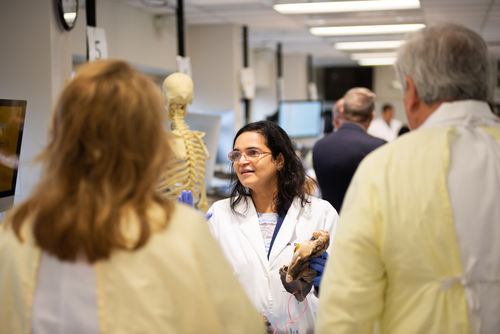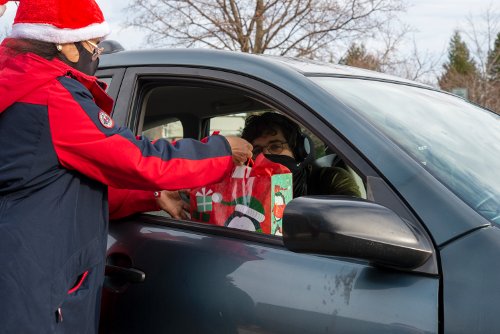
Varna Taranikanti, M.D., Ph.D., associate professor, recently was named Oakland University William Beaumont School of Medicine’s Foundational Medical Studies Educator of the Year.
Learn more about Taranikanti in the question-and-answer below, including the countries where she has taught, and her favorite part about being at OUWB.
What led you to a career as an anatomist, and do you remember what it was like the first time that you did a cadaveric dissection?
I have been actively engaged in teaching anatomical sciences (Gross anatomy, embryology, histology and neuroanatomy) to medical students for more than 20 years. I initially qualified as an M.D. in medicine. After internships I was extensively involved in clinical cancer research for five years however, participating and interacting with multi-disciplinary teams in cancer board meetings, I soon realized I was interested in an academic career. I joined a post graduate program of masters in surgery with a focus in anatomical sciences followed by a Ph.D. where I started honing dissection skills, learning microanatomy techniques, working on chick and pig embryos, slicing brain sections and correlating with MRI and CT scans as well as teaching medical students and helping surgery residents in anatomy dissection. I attribute my passion for teaching and my career into this amazing world of anatomy to my teachers who imparted their excellent knowledge and my students who forever drive me to lifelong learning.
Since completing my Ph.D., I have devoted my time into various aspects of medical education research such as active teaching/learning methodologies, pedagogy, formative/summative assessments, clinical integration and early clinical exposure. I get the gratification that I am also contributing to the health needs of the society in an indirect way.
When I see the excitement of the medical students in the anatomy lab, I reminisce about my first entry into the dissection hall as a first-year medical student, which is my most memorable moment. Still clearly etched in my mind is the unforgettable smell of formaldehyde, eagerly getting to know your dissection tank partners and above all who will be the first to use the scalpel on the cadaver. As I navigated through numerous dissections, I understood the complexity of the human body, the route the nerves take, the branching pattern of the vessels, the anomalies seen, the absence of a particular organ due to surgical intervention or the enlargement of an organ which could have been the cause of death. Although we don’t know who the cadaver was but sure “a dead person has many stories to tell.”
How have you changed as an instructor since you have adjusted to teaching anatomy during a pandemic?
To recreate a virtual learning environment with the sudden and unprecedented shuttering of the medical school was initially very daunting. However challenging, we as anatomy faculty at OUWB with help from IT staff, with meticulous planning had a seamless transition and were able to offer virtual labs as well as cadaver access to students following all the Covid safety norms. During this pandemic the students have shown tremendous grit, courage, and resilience in adjusting to the new norm of learning. We collectively as students and faculty refused to give up and emerged stronger.
Personally, I had few silver linings as well, I have become more technologically savvy such as upskilling in new software, utilizing best online anatomy software programs, and refreshing pedagogical techniques for online environments. I also utilized this opportunity to bring innovations in my teaching and assessments, which may result in scholarly activity in medical education.
As the saying goes, “Necessity is the mother of invention” It is most likely we may retain many of the new online techniques and approaches that are developed during the pandemic to create a more blended style of delivering learning in-person and remotely.
What is your favorite part about being a faculty member at OUWB?
I am a strong proponent of integration and early clinical exposure, which I believe brings relevance to learning. Integrated curriculum at OUWB has given me a wonderful opportunity to interact with colleagues professionally and enhanced my teaching, expanded it beyond my discrete discipline and assisted with leading to a range of education ventures such as developing innovations in assessments, research with clinical departments and imparting education at simulation center.
Having worked in different medical schools across the globe, I can say without hesitation that this is one school that values collegiality, diversity, teamwork, and it certainly “cares” about its faculty and students. I am proud and privileged to be a part of OUWB school of medicine.
You were one of the volunteers who passed out the “goodie bags of holiday cheer” to students who didn’t travel back home for the winter break last month. Why was it important for you to participate in that activity?
|
I had the opportunity to teach in different countries (India, Middle-east, UK, and U.S.) and understand different cultures. Across the globe, festivals are a time where you get time to spend time with your family and relax at home. At the end of the stressful semester, it is unfortunate that some of them were unable to make it to their homes due to various reasons. OUWB cares and being a part of OUWB family I felt that students should feel we are there for them. If not for COVID, I would have loved to have them at home to share the festivities and try out different “Indian Cuisines.”
Can you tell us one thing that people at OUWB probably don’t know about you?
I love cooking (Indian) and I am a sports enthusiast. Once the pandemic ends, I hope to host an open house during one of the festival seasons where we can relish the cuisine over a game of cricket.
To request an interview, visit the OUWB Communications & Marketing webpage.
NOTICE: Except where otherwise noted, all articles are published under a Creative Commons Attribution 3.0 license. You are free to copy, distribute, adapt, transmit, or make commercial use of this work as long as you attribute Oakland University William Beaumont School of Medicine as the original creator and include a link to this article.


